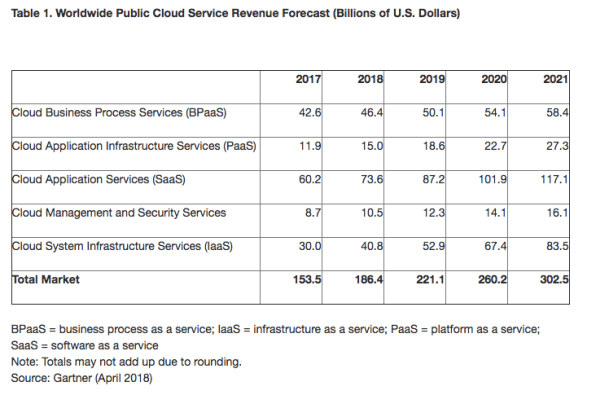If Your Biz Has Only One Cloud Provider, You’re Making A Mistake
More and more businesses are looking to the cloud as a simpler and more efficient way to run their business.
Continuing the ongoing trend, the worldwide public cloud services market is expected to grow 21.4% in 2018, bringing it to a total of $186.4 billion.
That’s an increase of $32.9 billion over last year, when the market was worth a total of $153.5 billion, according to Gartner, Inc.
One thing that is certainly changing is how businesses select their cloud service provider. While businesses would once select just one cloud service to work with, Gartner research director Sid Nag says that the multi-cloud market–where a business might spread out its cloud services over a few different companies–is growing. By 2019, Gartner predicts that multi-cloud will be the common strategy for 70% of enterprises.
“The idea of ‘multi-cloud’ is, essentially, when companies start to build up cloud, they look at their internal portfolios and workloads and applications they want for the cloud,” he says, “and they want to embrace the best-in-class technologies that different providers offer.” For instance, a company might use Amazon for a subscription service, but then look to Google for their AI functionality.
Nag feels strongly that businesses that make use of the cloud should diversify their cloud use over several companies, rather than rely on one provider for everything.
“Think about what you really want to accomplish, and think about the choices you have. Don’t get locked into one thing,” Nag advises. While four major vendors–Amazon, Google, Microsoft, and Alibaba–dominate the space, each of their offerings might not be as good as what you’ll get from another provider for a specific part of your business.

For instance, if you decide to work exclusively with Amazon, then you’re stuck using whatever Amazon might offer for AI. Yes, that might work for you, but what Google or Microsoft is offering might be better for your particular use case. Case in point: A photo-based service might find Google’s intelligent image searching capabilities more accurate than those offered by Amazon. In contrast, Amazon might be better at language processing.
By choosing one provider, you also put all parts of your business in a vulnerable position when the only cloud provider you use decides to raise rates.
The move to a multi-cloud strategy is one that Nag thinks will ultimately lead vendors to create a simpler way to transfer workloads, application, and data across providers–a journey that features more than a few speed bumps today that make migrating all of your data from one service to another often a more complicated process than it’s worth.
Meanwhile, public cloud revenue–revenue from companies that are doing things like offering virtual servers–is set to keep on growing. While we’ve seen a pretty significant jump over the past few years in that space, Nag says we’ll start to see more lateral growth growing forward. But that isn’t indicative of the market slowing down, but rather of the market’s maturity.
“The cloud industry has grown significantly over the past two to three years,” says Nag. He says that the era where businesses are just toying around with the cloud for a DevOps or high-performance computing project is over.
“Cloud service providers have really ramped up their offerings in terms of capabilities, skills, feature functionalities, availability, robustness, and all of that. Today you see an environment where businesses are really making cloud a core part of their businesses’ IT strategy,” he says.
The fastest-growing segment of the market is cloud system infrastructure services (IaaS), which are expected to grow by 35.9% in 2018 to reach $40.8 billion. That includes services such as Amazon Web Services (AWS) and Google Cloud Platform (GCP), which are essentially hosting infrastructure components you might typically expect to find onsite. Think things like servers, data storage, and networking hardware.
The top 10 providers in that market were responsible for 50% of the category’s revenue in 2016–but are expected to account for nearly 70% of the space by 2021.
(36)



